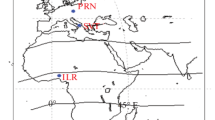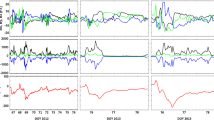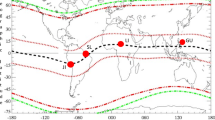Abstract
The ionospheric response to geomagnetic storms is usually investigated by considering the variability of the critical frequency of the F2-layer (foF2) or the total electron content (TEC) because these two parameters are directly measured by the ionosonde stations and the Global Navigation Satellite Systems (GNSS). In the present paper, however, the reaction is explored by using the vertical profiles of the electron density, N(h), reconstructed by manually scaled ionosonde measurements at the station Sofia (42.4°N, 23.2°E). The mid-latitude ionosheric response to three geomagnetic storms that occurred in January 2005 is presented as this period has been selected because no major sudden stratospheric warming occurred during this month, and the winter 2005 is given in the literature as an example of a “normal” year. Hence the observed ionospheric response to the considered geomagnetic storms can be attributed mainly to the external forcing. Besides the traditional parameters foF2 and TEC, a particular attention is paid to the variability of the peak electron density height (hmF2). This study reveals for the first time that the main contribution to the response of the midlatitude ionosphere to moderate/intense winter geomagnetic storms is associated with significant enhancements of short-period quasi-diurnal oscillations with period of 6–7 hours observed in both foF2 and hmF2. An explanation of the main mechanisms responsible for the distortion of the diurnal ionospheric variability during these storms is offered. This result is especially important for the ground-based HF radio communications.
Similar content being viewed by others

References
Astafyeva E., Zakharenkova I. and Förster M., 2015. Ionospheric response to the 2015 St. Patrick’s Day storm: A global multi-instrumental overview. J. Geophys. Res.-Space Phys., 120, 9023–9037, DOI: https://doi.org/10.1002/2015JA021629.
Andonov B., Mukhtarov P. and Pancheva D., 2011. Empirical model of the TEC response to the geomagnetic activity over the North American region. Adv. Space Res., 48, 1041–1048, DOI: https://doi.org/10.1016/j.asr.2011.05.007.
Balan N., Shiokawa K., Otsuka Y., Kikuchi T., Vijaya Lekshmi D., Kawamura S., Yamamoto M. and Bailey G.J., 2010. A physical mechanism of positive ionospheric storms at low latitudes and midlatitudes. J. Geophys. Res.-Space Phys., 115, A02304, DOI: https://doi.org/10.1029/2009JA014515.
Blanc M. and Richmond A.D., 1980. The ionospheric disturbance dynamo J. Geophys. Res., 85(A4), 1669–1699.
Buonsanto M.J. 1999. Ionospheric storms: A review. Space Sci. Rev., 88, 563–601.
Foster J.C., Erickson P.J., Coster A.J., Goldstein J. and Rich F.J., 2002. Ionospheric signatures of plasmaspheric tails. Geophys. Res. Lett., 29, 1623, DOI: https://doi.org/10.1029/2002GL015067.
Fuller-Rowell T.J., Codrescu M.V. and Wilkinson M., 2000. Quantitative modelling of the ionospheric response to geomagnetic activity. Ann. Geophys., 18, 766–781.
Hanson W.B. and Patterson T.N.L., 1964. The maintenance of the nighttime F layer. Planet. Space Sci., 12, 979–997.
Heelis R.A., Sojka J.J., David M. and Schunk R.W., 2009. Storm time density enhancements in the mid latitude dayside ionosphere. J. Geophys. Res.-Space Phys., 114, A03315, DOI: https://doi.org/10.1029/2008JA013690.
Jakowski N., Wilken V., Schlueter S., Stankov S.M. and Heise S., 2005. Ionospheric space weather effects monitored by simultaneous ground and spaced based GNSS signals. J. Atmos. Sol.-Terr. Phys., 67, 1074–1084.
Jakowski N., Mielich J., Borries C., Cander L., Krankowski A., Nava B. and Stankov S.M., 2008. Large scale ionospheric gradients over Europe observed in October 2003. J. Atmos. Sol.-Terr. Phys., 70, 1894–1903.
Katamzi Z.T., Habarulema J.B. and Giday N.M., 2016. Daytime twin-peak structures observed at southern African and European middle latitudes on 8–13 April 2012. Ann. Geophys., 34, 581–590, DOI: https://doi.org/10.5194/angeo-34-581-2016.
Kelley M.C., Vlasov M.N., Foster J.C. and Coster A.J., 2004. A quantitative explanation for the phenomenon known as storm-enhanced density. Geophys. Res. Lett., 31, L19809, DOI: https://doi.org/10.1029/2004GL020875.
Khan Z.M., Ara H., Iqbal S. and Nasir M., 1985. On the cause of fore-noon and post-noon bite-outs in foF2. J. Atmos. Terr. Phys., 47, 719–724.
Kutiev I. and Muhtarov P., 2001. Modeling of midlatitude F-region response to geomagnetic activity. J. Geophys. Res.-Space Phys., 106, 15501–15510.
Kutiev I. and Muhtarov P., 2003. Empirical modeling of global ionospheric foF2 response to geomagnetic activity. J. Geophys. Res.-Space Phys., 108, 1021, DOI: https://doi.org/10.1029/2001JA009134.
Lin C.H., Richmond A.D., Liu J.Y., Yeh H.C., Paxton L.J., Lu G., Tsai H.F. and Su S.-Y., 2005. Large-scale variations of the low-latitude ionosphere during the October-November 2003 superstorm: Observational results. J. Geophys. Res.-Space Phys., 110, A09S28, DOI: https://doi.org/10.1029/2004JA010900.
Lu G., Goncharenko L.P., Richmond A.D., Roble R.G. and Aponte N., 2008. A dayside ionospheric positive storm phase driven by neutral winds. J. Geophys. Res.-Space Phys., 113, A08304, DOI: https://doi.org/10.1029/2007JA012895.
Lynn K.J.W., Gardiner-Garden R.S. and Heitmann A., 2014. The spatial and temporal structure of twin peaks and midday bite out in foF2 (with associated height changes) n the Australian and South Pacific low midlatitude ionosphere. J. Geophys. Res.-Space Phys., 119, 10294–10304, DOI: https://doi.org/10.1002/2014JA020617.
McKenna-Lawlor S., Li L., Dandouras I., Brandt P.C., Zheng Y., Barabash S., Bucik R., Kudela K., Balaz J. and Strharsky I., 2010. Moderate geomagnetic storm (21–22 January 2005) triggered by an outstanding coronal mass ejection viewed via energetic neutral atoms. J. Geophys. Res.-Space Phys., 115, A08213, DOI: https://doi.org/10.1029/2009JA014663.
Manney G.L., Schwartz M.J., Krüger K., Santee M.L., Pawson S., Lee J.N., Daffer W.H., Fuller R.A. and Livesey N.J., 2009. Aura Microwave Limb Sounder observations of dynamics and transport during the record-breaking 2009 Arctic stratospheric major warming. Geophys. Res. Lett., 36, L12815, DOI: https://doi.org/10.1029/2009GL038586.
Mendillo M., 2006. Storms in the ionosphere: Patterns and processes for total electron content. Rev. Geophys., 44, RG4001, DOI: https://doi.org/10.1029/2005RG000193.
Muhtarov P. and Kutiev I., 1998. Empirical modeling of ionospheric storms at midlatitudes. Adv. Space Res., 22, 829–835.
Mukhtarov P., Penov N. and Pancheva, D. 2013. N(h) profiles derived from ionograms and their application for studying mid-latitude ionospheric response to geomagnetic storms. C.R. Acad. Bulg. Sci., 66(9), 1315–1322.
Mukhtarov P. and Bojilova R., 2017. Influence of solar and geomagnetic activity on the ionosphere over Bulgaria. C.R. Acad. Bulg. Sci., 70(9), 1289–1296.
Mukhtarov P. and Pancheva D., 2012. Thermosphere-ionosphere coupling in response to recurrent geomagnetic activity J. Atmos. Sol.-Terr. Phys., 90–91, 132–145, DOI: https://doi.org/10.1016/j.jastp.2012.02.013.
Pancheva D., Mukhtarov P. and Andonov B., 2016. Global structure of ionospheric TEC anomalies driven by geomagnetic storms. J. Atmos. Sol.-Terr. Phys., 145, 170–182, DOI: https://doi.org/10.1016/j.jastp.2016.04.015.
Pi X., Mendillo M., Fox M.W. and Anderson D.N., 1993. Diurnal double maxima patterns in the F region ionosphere: substorm-related analysis aspects. J. Geophys. Res.-Space Phys., 98, 13677–13691.
Prölss G.W., 1980. Magnetic storm associated perturbations of the upper atmosphere: Recent results obtained with satellite-borne gas analyzers. Rev. Geophys. Space Phys., 18, 183–202.
Prölss G.W., 2008. Ionospheric storms at mid-latitudes: a short review. In: Kintner P.M. (Ed.), Midlatitude Ionospheric Dynamics and Disturbances. AGU Monograph 181, American Geophysical Union, Washington, D.C., 9–24.
Prölss G.W., 2011. Density perturbations in the upper atmosphere caused by the dissipation of solar wind energy. Surv. Geophys., 32, 101–195.
Reinisch B. and Huang X., 1983. Automatic calculation of electron density profiles from digital ionograms: 3. Processing of bottomside ionograms. Radio Sci., 18, 477–492.
Richmond A.D., Peymirat C. and Roble R.G., 2003. Long-lasting disturbances in the equatorial ionospheric electric field simulated with a coupled magnetosphere-ionosphere-thermosphere model. J. Geophys. Res.-Space Phys., 108, 1118, DOI: https://doi.org/10.1029/2002JA009758.
Rishbeth H., 1967. The effect of winds on the ionospheric F2 peak. J. Atmos. Terr. Phys., 29, 225–238.
Rishbeth H., 1972. Thermospheric winds and the F-region: A review. J. Atmos. Terr. Phys., 34, 1–47.
Rishbeth H., 1991. F-region storms and thermospheric dynamics. J. Geomagn. Geoelectr., 43 (Suppl.), 513–524.
Rishbeth H., 1998. How the thermospheric circulation affects the ionospheric F2-layer. J. Atmos. Terr. Phys., 60, 1385–1402.
Sahai Y., Fagundes P.R., de Jesus R., de Abreu A.J., Crowley G., Kikuchi T., Huang C.S., Pillat V.G., Guarnieri F.L., Abalde J.R. and Bittencourt J.A., 2011. Studies of ionospheric F-region response in the Latin American sector during the geomagnetic storm of 21–22 January 2005. Ann. Geophys., 29, 919–929, DOI: https://doi.org/10.5194/angeo-29-919-2011.
Saryo T., Takeda M., Araki T., Sato T., Tsuda T., Fukao S. and Kato S., 1989. A midday bite-out event of the F2-layer observed by MU radar. J. Geomagn. Geoelectr., 41, 727–734.
Shimazaki T., 1964. Nighttime variations of F-region electron density profiles at Puerto Rico. J. Geophys. Res., 69, 2781–2797.
Stankov S.M. and Jakowski N., 2007. Ionospheric effects on GNSS reference network integrity. J. Atmos. Sol.-Terr. Phys., 69, 485–499.
Trichtchenko L., Zhukov A., Van Der Linden R., Stankov S.M., Jakowski N., Stanislawska I., Juchnikowski G., Wilkinson P., Patterson G. and Thomson A.W.P., 2007. November 2004 space weather events — real time observations and forecasts. Space Weather, 5, S06001, DOI: https://doi.org/10.1029/2006SW000281.
Wang W., Lei J., Burns A.G., Solomon S.C., Wiltberger M., Xu J., Zhang Y., Paxton L. and Coster A., 2010. Ionospheric response to the initial phase of geomagnetic storms: Common features. J. Geophys. Res.-Space Phys., 115, A07321, DOI: https://doi.org/10.1029/2009JA014461.
Winick J.R., Wintersteiner P.P., Picard R.H., Esplin D., Mlynczak M.G., Russell III J.M. and Gordley L.L., 2009. OH layer characteristics during unusual boreal winters of 2004 and 2006, J. Geophys. Res.-Space Phys., 114, A02303, DOI: https://doi.org/10.1029/2008JA013688.
Zhang S.-R., Fukao S., Oliver W.L. and Otsuka Y., 1999. The height of the maximum ionospheric electron density over the MU radar. J. Atmos. Sol.-Terr. Phys., 61, 1367–1383.
Author information
Authors and Affiliations
Corresponding author
Rights and permissions
About this article
Cite this article
Bojilova, R., Mukhtarov, P. Response of the electron density profiles to geomagnetic disturbances in January 2005. Stud Geophys Geod 63, 436–454 (2019). https://doi.org/10.1007/s11200-019-0510-6
Received:
Revised:
Accepted:
Published:
Issue Date:
DOI: https://doi.org/10.1007/s11200-019-0510-6



